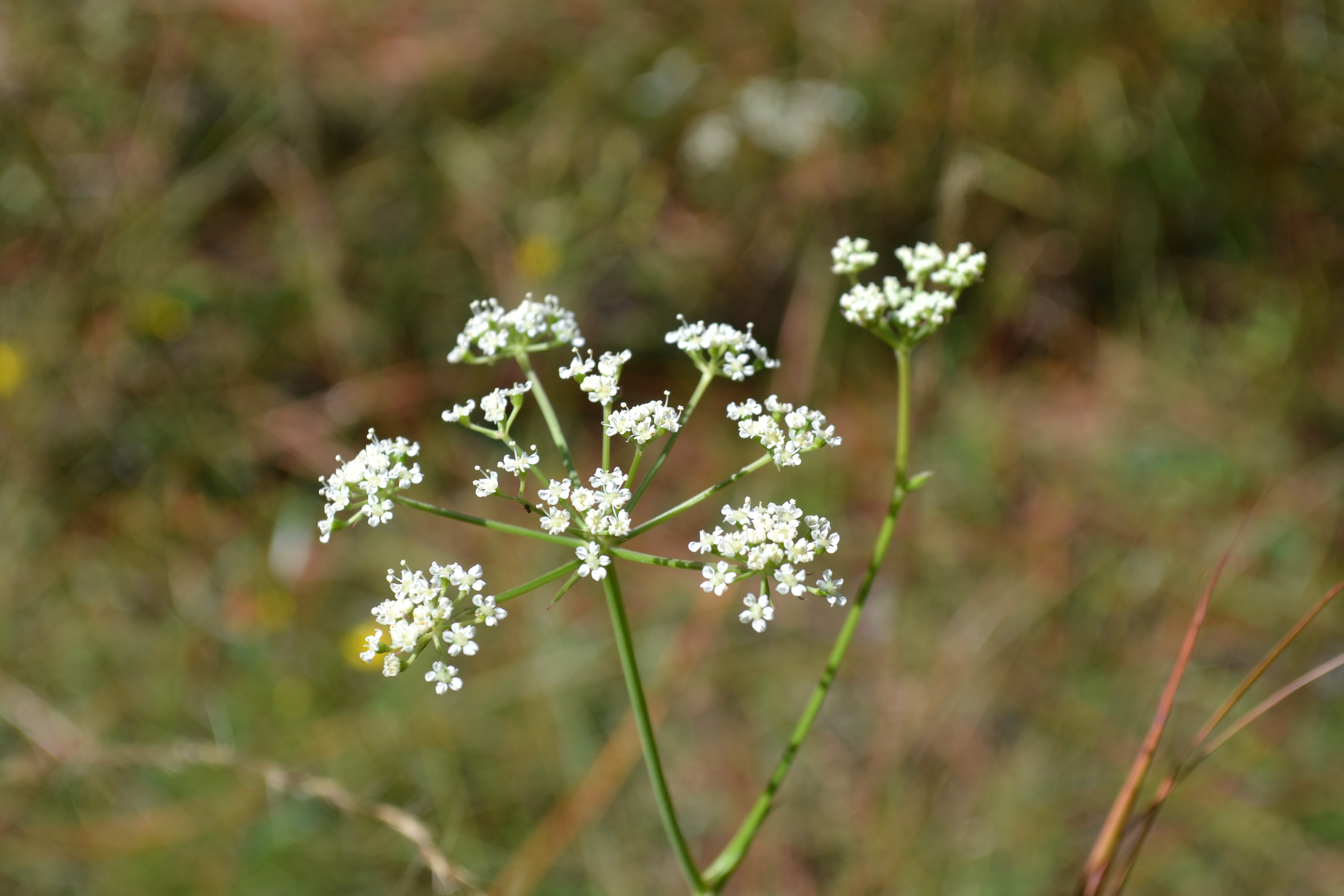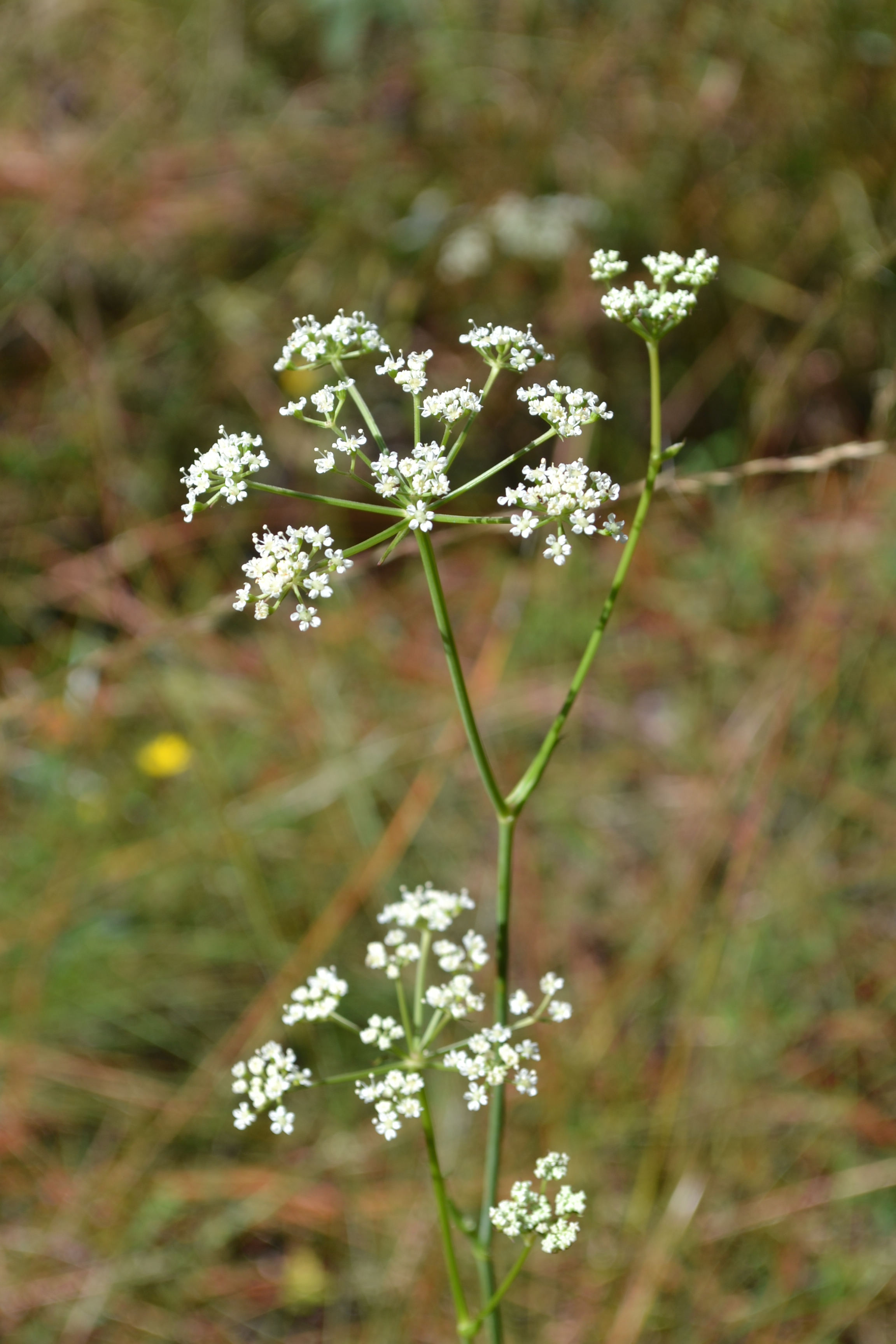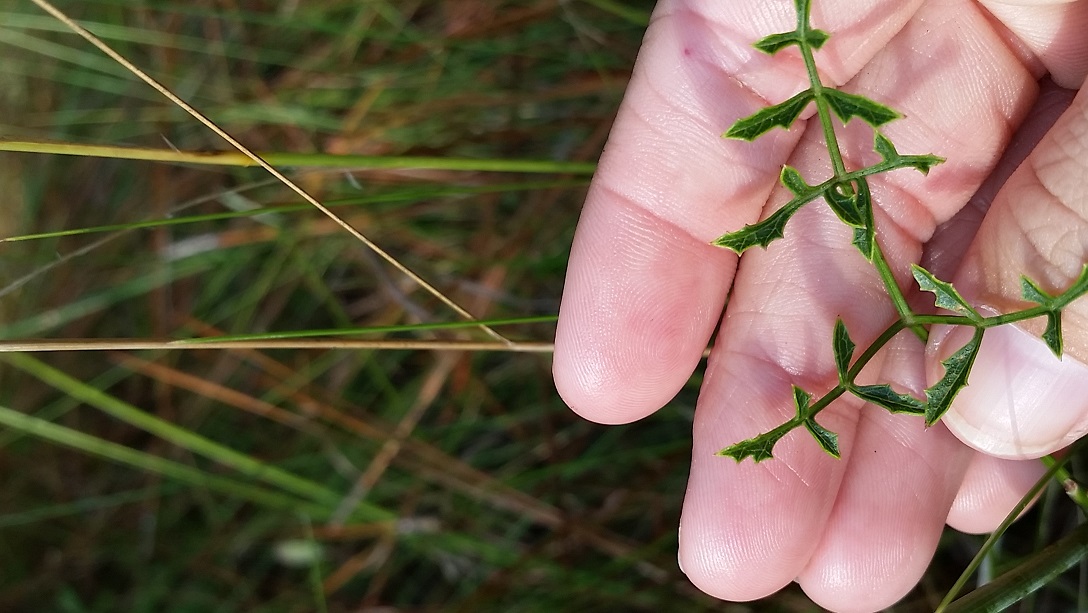Difference between revisions of "Angelica dentata"
(→Description) |
Adam.Vansant (talk | contribs) |
||
| (80 intermediate revisions by 15 users not shown) | |||
| Line 15: | Line 15: | ||
| binomial_authority = (Chapm.) J.M. Coult. & Rose | | binomial_authority = (Chapm.) J.M. Coult. & Rose | ||
| range_map = ANGE_DENT_dist.jpg | | range_map = ANGE_DENT_dist.jpg | ||
| − | | range_map_caption = Natural range of ''Angelica dentata'' from USDA NRCS [http://www.plants.usda.gov Plants Database]. | + | | range_map_caption = Natural range of ''Angelica dentata'' from USDA NRCS [http://www.plants.usda.gov/core/profile?symbol=ANDE4 Plants Database]. |
}} | }} | ||
| + | Common names: Coastal Plain angelica; Sandhill angelica | ||
| + | ==Taxonomic notes== | ||
| + | Synonyms: none.<ref name="weakley">Weakley, A.S. 2015. Flora of the southern and mid-atlantic states. Working Draft of 21 May 2015. University of North Carolina at Chapel Hill, Chapel Hill, North Carolina.</ref> | ||
| + | |||
| + | Varieties: none.<ref name="weakley"/> | ||
| + | |||
==Description== | ==Description== | ||
<!-- Basic life history facts such as annual/perrenial, monoecious/dioecious, root morphology, seed type, etc. --> | <!-- Basic life history facts such as annual/perrenial, monoecious/dioecious, root morphology, seed type, etc. --> | ||
| − | + | ''Angelica dentata'' is a perennial herb with erect, hairless stems growing 20 - 40 inches (50 - 100 cm) tall. The leaves grow on long leaf stalks, each leaf divided into several, leathery, lance-shaped, coarsely toothed leaflets. The flowers grow in flat-topped clusters, composed of 5 - 12 smaller clusters of tiny, white flowers. The flower stalks are hairless, and flowers themselves have 5 white, spreading petals. The fruits are about 1/4 inch (5 - 6 mm) long, hairless, oval, flattened, ribbed, and winged.<ref name="georgia">[[http://georgiawildlife.com/sites/default/files/uploads/wildlife/nongame/pdf/accounts/plants/angelica_dentata.pdf]]Georgia Wildlife. Accessed: March 29, 2016</ref> Flowers are arranged in umbels and are compound and bisexual.<ref name="wildflowers">[[http://wildflowers.jdcc.edu/Angelica.html]]Accessed: March 29, 2016</ref> | |
==Distribution== | ==Distribution== | ||
| + | It is found in southwest and south-central Georgia and in the eastern part of the panhandle of Florida.<ref name="weakley"/> However, one study found the presence of ''A. dentata'' in south Alabama.<ref name= "Carter">Carter, R. E., et al. (2004). "Species composition of fire disturbed ecological land units in the Southern Loam Hills of south Alabama." Southeastern Naturalist 3: 297-308.</ref> | ||
| + | |||
| + | ==Ecology== | ||
| + | ===Habitat===<!--Natural communities, human disturbed habitats, topography, hydrology, soils, light, fire regime requirements for removal of competition, etc.--> | ||
| + | ''A. dentata'' is restricted to native groundcover and is commonly associated with upland pinelands of South Georgia. It was found to decrease in coverage in response to agricultural disturbance in southwest Georgia. Additionally, it has shown resistance to regrowth in reestablished pine communities that had been disturbed by agricultural practices.<ref name="ostertag">Ostertag, T.E., and K.M. Robertson. 2007. A comparison of native versus old-field vegetation in upland pinelands managed with frequent fire, South Georgia, USA. Pages 109–120 in R.E. Masters and K.E.M. Galley (eds.). Proceedings of the 23rd Tall Timbers Fire Ecology Conference: Fire in Grassland and Shrubland Ecosystems.</ref> Additionally, ''A. dentata'' has been found to be a decreaser in its long-term response following cessation of repeated soil disturbance.<ref name=Dixon>Dixon, C. M., K. M. Robertson, A. M. Reid and M. T. Rother. 2024. Mechanical soil disturbance in a pine savanna has multiyear effects on plant species composition. Ecosphere 15(2):e4759.</ref> Habitats include sandhills, longleaf pine-wiregrass savannas, longleaf-scrub oaks, boggy areas, and pine flatwoods. It occurs in disturbed areas such as roadsides and logged fields. Thrives in areas that are open or semi-shaded. Soils include dry sand, gravelly soil, loamy sand and dry and moist loamy soil.<ref name="fsu">Florida State University Robert K. Godfrey Herbarium database. URL: http://herbarium.bio.fsu.edu. Last accessed: June 2014. Collectors: L. C. Anderson, W. Baker, B. Boothe, M. Boothe, A. F. Clewell, V. Craig, M. A. Garland, R. K. Godfrey, R. Kral, E. Keppner, L. Keppner, R. Komarek, T. MacClendon, K. MacClendon, R. A. Pursell, H. Roth, and R. White. States and Counties: Florida: Bay, Calhoun, Franklin, Gadsden, Jackson, Leon, Liberty, and Wakulla. Georgia: Decatur, Grady, and Thomas.</ref><ref name="weakley"/> | ||
| + | ''Angelica dentata'' is an indicator species for the Panhandle Silty Longleaf Woodlands community type as described in Carr et al. (2010).<ref>Carr, S.C., K.M. Robertson, and R.K. Peet. 2010. A vegetation classification of fire-dependent pinelands of Florida. Castanea 75:153-189.</ref> | ||
| + | |||
| + | Associated species: ''Croton'' sp., ''[[Pinus palustris]]'', ''[[Quercus laevis]]'', ''Quercus margaretta'', ''Rhynchosia'' sp., ''[[Symphyotrichum dumosum]]'', ''Carphephorus odoratissiumus'', ''Carphephorus paniculatus'', ''Chrysopsis'' sp., and ''Symphiotrichum dumosum''.<ref name="fsu"/> | ||
| + | |||
| + | ===Phenology===<!--Timing off flowering, fruiting, and environmental triggers. Cite PanFlora website if appropriate: http://www.gilnelson.com/PanFlora/ --> | ||
| + | ''Angelica dentata'' has been observed to flower June through January.<ref name="fsu"/><ref>Nelson, G. [http://www.gilnelson.com/ PanFlora]: Plant data for the eastern United States with emphasis on the Southeastern Coastal Plains, Florida, and the Florida Panhandle. www.gilnelson.com/PanFlora/ Accessed: 7 DEC 2016</ref> | ||
| − | |||
| − | |||
| − | |||
| − | |||
===Seed dispersal=== | ===Seed dispersal=== | ||
| − | ===Seed bank and germination=== | + | Seeds are dispersed by gravity and small animals.<ref name="georgia"/> |
| − | ===Fire ecology=== <!--Fire tolerance, fire dependence, adaptive fire responses--> | + | |
| + | <!--===Seed bank and germination===--> | ||
| + | |||
| + | ===Fire ecology===<!--Fire tolerance, fire dependence, adaptive fire responses--> | ||
| + | ''Angelica dentata'' can be found in frequently burned areas such as longleaf pine savannas.<ref name="fsu"/> Populations have been known to persist through repeated annual burns.<ref>Robertson, K.M. Unpublished data collected from Pebble Hill Fire Plots, Pebble Hill Plantation, Thomasville, Georgia.</ref> | ||
| + | |||
===Pollination=== | ===Pollination=== | ||
| − | == | + | ''Angelica dentata'' is pollinated by wasps, flies, beetles and bees.<ref name="georgia"/> In Franklin County, FL, wasp pollinators include those from the family Vespidae.<ref name="Griffith 2015">Observation by Floyd Griffith in Franklin County, FL, November 14, 2015, posted to Florida Flora and Ecosystematics Facebook group November 16, 2015.</ref> |
| − | ===Diseases and parasites=== | + | |
| − | ==Conservation and | + | <!--===Herbivory and toxicology===--> |
| − | == | + | <!--===Diseases and parasites===--> |
| + | |||
| + | ==Conservation, cultivation, and restoration== | ||
| + | Threats include conversion of habitat to pine plantations, agriculture, pastures, development and fire suppression.<ref name="georgia"/> This species should avoid soil disturbance by agricultural practices to conserve its presence in pine communities.<ref name="ostertag"/> | ||
| + | |||
| + | ==Cultural use== | ||
==Photo Gallery== | ==Photo Gallery== | ||
| − | + | <gallery widths=180px> | |
| + | File:Angelica dentata PH 2012 (2).JPG| <center> ''Angelica dentata'' <p> Photo by Kevin Robertson </p> | ||
| + | |||
| + | File:Angelica denata leaves MMS PH Oct 2015.jpg| <center> Leaves of ''Angelica dentata'' <p> Photo by Michelle Smith </p><p> Grady County, GA | ||
| + | </nowiki></gallery> | ||
==References and notes== | ==References and notes== | ||
| − | |||
Latest revision as of 19:33, 10 July 2024
| Angelica dentata | |
|---|---|

| |
| Photo taken by Kevin Robertson | |
| Scientific classification | |
| Kingdom: | Plantae |
| Division: | Magnoliophyta - Flowering plants |
| Class: | Magnoliopsida – Dicotyledons |
| Order: | Apiales |
| Family: | Apiaceae ⁄ Umbelliferae |
| Genus: | Angelica |
| Species: | A. dentata |
| Binomial name | |
| Angelica dentata (Chapm.) J.M. Coult. & Rose | |

| |
| Natural range of Angelica dentata from USDA NRCS Plants Database. | |
Common names: Coastal Plain angelica; Sandhill angelica
Contents
Taxonomic notes
Synonyms: none.[1]
Varieties: none.[1]
Description
Angelica dentata is a perennial herb with erect, hairless stems growing 20 - 40 inches (50 - 100 cm) tall. The leaves grow on long leaf stalks, each leaf divided into several, leathery, lance-shaped, coarsely toothed leaflets. The flowers grow in flat-topped clusters, composed of 5 - 12 smaller clusters of tiny, white flowers. The flower stalks are hairless, and flowers themselves have 5 white, spreading petals. The fruits are about 1/4 inch (5 - 6 mm) long, hairless, oval, flattened, ribbed, and winged.[2] Flowers are arranged in umbels and are compound and bisexual.[3]
Distribution
It is found in southwest and south-central Georgia and in the eastern part of the panhandle of Florida.[1] However, one study found the presence of A. dentata in south Alabama.[4]
Ecology
Habitat
A. dentata is restricted to native groundcover and is commonly associated with upland pinelands of South Georgia. It was found to decrease in coverage in response to agricultural disturbance in southwest Georgia. Additionally, it has shown resistance to regrowth in reestablished pine communities that had been disturbed by agricultural practices.[5] Additionally, A. dentata has been found to be a decreaser in its long-term response following cessation of repeated soil disturbance.[6] Habitats include sandhills, longleaf pine-wiregrass savannas, longleaf-scrub oaks, boggy areas, and pine flatwoods. It occurs in disturbed areas such as roadsides and logged fields. Thrives in areas that are open or semi-shaded. Soils include dry sand, gravelly soil, loamy sand and dry and moist loamy soil.[7][1]
Angelica dentata is an indicator species for the Panhandle Silty Longleaf Woodlands community type as described in Carr et al. (2010).[8]
Associated species: Croton sp., Pinus palustris, Quercus laevis, Quercus margaretta, Rhynchosia sp., Symphyotrichum dumosum, Carphephorus odoratissiumus, Carphephorus paniculatus, Chrysopsis sp., and Symphiotrichum dumosum.[7]
Phenology
Angelica dentata has been observed to flower June through January.[7][9]
Seed dispersal
Seeds are dispersed by gravity and small animals.[2]
Fire ecology
Angelica dentata can be found in frequently burned areas such as longleaf pine savannas.[7] Populations have been known to persist through repeated annual burns.[10]
Pollination
Angelica dentata is pollinated by wasps, flies, beetles and bees.[2] In Franklin County, FL, wasp pollinators include those from the family Vespidae.[11]
Conservation, cultivation, and restoration
Threats include conversion of habitat to pine plantations, agriculture, pastures, development and fire suppression.[2] This species should avoid soil disturbance by agricultural practices to conserve its presence in pine communities.[5]
Cultural use
Photo Gallery
References and notes
- ↑ 1.0 1.1 1.2 1.3 Weakley, A.S. 2015. Flora of the southern and mid-atlantic states. Working Draft of 21 May 2015. University of North Carolina at Chapel Hill, Chapel Hill, North Carolina.
- ↑ 2.0 2.1 2.2 2.3 [[1]]Georgia Wildlife. Accessed: March 29, 2016
- ↑ [[2]]Accessed: March 29, 2016
- ↑ Carter, R. E., et al. (2004). "Species composition of fire disturbed ecological land units in the Southern Loam Hills of south Alabama." Southeastern Naturalist 3: 297-308.
- ↑ 5.0 5.1 Ostertag, T.E., and K.M. Robertson. 2007. A comparison of native versus old-field vegetation in upland pinelands managed with frequent fire, South Georgia, USA. Pages 109–120 in R.E. Masters and K.E.M. Galley (eds.). Proceedings of the 23rd Tall Timbers Fire Ecology Conference: Fire in Grassland and Shrubland Ecosystems.
- ↑ Dixon, C. M., K. M. Robertson, A. M. Reid and M. T. Rother. 2024. Mechanical soil disturbance in a pine savanna has multiyear effects on plant species composition. Ecosphere 15(2):e4759.
- ↑ 7.0 7.1 7.2 7.3 Florida State University Robert K. Godfrey Herbarium database. URL: http://herbarium.bio.fsu.edu. Last accessed: June 2014. Collectors: L. C. Anderson, W. Baker, B. Boothe, M. Boothe, A. F. Clewell, V. Craig, M. A. Garland, R. K. Godfrey, R. Kral, E. Keppner, L. Keppner, R. Komarek, T. MacClendon, K. MacClendon, R. A. Pursell, H. Roth, and R. White. States and Counties: Florida: Bay, Calhoun, Franklin, Gadsden, Jackson, Leon, Liberty, and Wakulla. Georgia: Decatur, Grady, and Thomas.
- ↑ Carr, S.C., K.M. Robertson, and R.K. Peet. 2010. A vegetation classification of fire-dependent pinelands of Florida. Castanea 75:153-189.
- ↑ Nelson, G. PanFlora: Plant data for the eastern United States with emphasis on the Southeastern Coastal Plains, Florida, and the Florida Panhandle. www.gilnelson.com/PanFlora/ Accessed: 7 DEC 2016
- ↑ Robertson, K.M. Unpublished data collected from Pebble Hill Fire Plots, Pebble Hill Plantation, Thomasville, Georgia.
- ↑ Observation by Floyd Griffith in Franklin County, FL, November 14, 2015, posted to Florida Flora and Ecosystematics Facebook group November 16, 2015.

